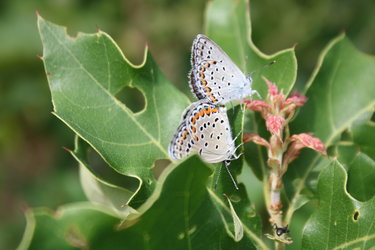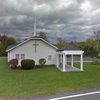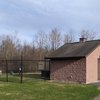Guilderland looks to adopt comprehensive plan by October
— Enterprise file photo
The Karner blue butterfly, an endangered species, makes it home in the Albany Pine Bush. Members of the not-for-profit Save the Pine Bush are asking Guilderland to include as part of its update to the town’s comprehensive plan a strategy to scoop up all available undeveloped land in the Pine Bush.
GUILDERLAND — Preserving rural western Guilderland, housing, and saving the Pine Bush were topics addressed by a handful of speakers during the latest public hearing on the update to Guilderland’s two-decades-old land-use plan, which the town board hopes to adopt in the next couple of months.
During the Aug. 19 town board meeting, Supervisor Peter Barber said the board had “the goal of adopting the comp plan at a meeting in October.” He also said that residents would have another chance to comment on the proposed plan, at the board’s September meeting,
“But a lot of things have to happen between now and then,” he said
Since the last public hearing, Barber said the town had received additional comments, noting specifically that Save the Pine Bush “provided us with a detailed letter with supporting documentation.” He then said Town Planner Kenneth Kovalchik would take a look at the submittal and “incorporate what he can. And then, if he can’t, tell us reasons why or why not.”
Western Guilderland
Ken McIver of Armstrong Drive spoke about development on the western edge of Guilderland.
“There are several items which, when taken together, can lead one to the conclusion that the plan is a blueprint for development in the western end of the town,” he said. “Given some of the changes that have been included in the latest revision of the plan, I am more convinced of this opinion than ever.”
McIver said the town’s 2005 open-space and farmland protection plan spoke to “minimizing the intensity of new development throughout the countryside.”
That plan, according to McIver, said, if not for the lack of infrastructure, the buildout of rural Guilderland could have resulted in approximately 6,600 new units and 16,000 new residents.
“The authors felt that the community's vision was not adequately expressed through the existing zoning regulations that allowed for that type of growth. At that time,” he said, referencing two decades ago, “they also believed that development intensity allowed by the town's zoning ordinances should have been reduced to more closely match the capacity of the environment and the community's vision for appropriate growth. I think the same should apply today.”
McIver was also concerned about the section of the update referencing a water interconnection with the village of Altamont, raising similar questions touched on by speakers at earlier meetings, particularly that a water line could lead to more development in that rural part of town. Altamont Mayor Kerry Dineen has repeatedly said the interconnect would be for emergency use only.
Flooding
Lisa Hart, who was on the comprehensive plan update committee as well as its housing and transportation subcommittees, read through a section of the updated plan referencing Stuyvesant Plaza that effectively said, when it rains, there’s flooding at the Route 20 entrance.
“Personally, I think there just needs to be something regarding either some kind of action plan to try and remedy the flooding instead of just saying it happens during heavy rain events,” Hart said. “I’m sure all town residents and visitors would love to know if there’s going to be anything in the plan at some point to be done about this.”
Housing
She then moved to a portion of the plan not discussed in her two years on the update committee
Referring to comments made during an earlier public hearing, Hart said she didn’t think the Housing Affordability and Missed Opportunity section should even be included in the plan.
“I understand it was a suggestion from the planning board and the reasoning behind it, but I don’t think it should be in there either,” she said. “This plan is to help create a better future for our town. It’s not to look back and see what could have been.”
Robyn Gray, who chairs the Guilderland Coalition for Responsible Growth, told the board, “One of the things that was mentioned when we did the neighborhood and housing [subcommittee] was creating an affordable-home zone. There is absolutely no mention of that in the comprehensive plan.
Gray said research she had done on housing trends show that, with a rising number of people working from home, the preference for apartments has waned.
People are now seeking suburban homes with yards, she said, adding, “They also want affordable housing.”
Gray went on, “I think we need to really take a look at what we are doing for multi-family units and apartments — I don’t want to call them all apartments, but that’s what they are. I’m not talking about the projects that are all affordable housing; I’m talking about the ones where people are coming in and saying, ‘Oh, we’re going to do market-rate apartments.’
“I don’t think we really need any. If you look at the data, we’ve had — and this was discussed at the planning board — the percentages of apartments versus homes have not changed in 20 years.”
Gray continued, “What that tells me — and I believe [planning board chairman Stephen] Feeney said this too — is, ‘Do we really need more apartments?’ The answer was that we need affordable housing; we need affordable apartments for seniors and young families. We don't need more market-rate apartments. I think that's something that needs to be looked at and considered.
Not wanting to call it a “tiny home” community, Gray said the town should look to create “a neighborhood with smaller homes on smaller lots where people have their own little piece of paradise; most people would be happy with that.”
Pine bush
Members of the not-for-profit Save the Pine Bush spoke to the board about saving the rare ecosystem.
Lynne Jackson, one of the group’s founders, asked that the comments made by Save the Pine Bush be added to the updated comprehensive plan, and thanked the board for adding a section about the town coming up with a plan to acquire land.
“I think it is a laudable goal that the town of Guilderland would like to work toward preserving 30 percent of its land as open space,” she said. “However, I don’t think that’s enough because you really do need to protect the rest of the pine bush. The Albany Pine Bush is not just on the edge of our cities and towns; it is one of the rarest ecosystems on Earth.”
Andy Arthur, also of Save the Pine Bush, told the board, “Every year, we’ve seen a little bit more of the Pine Bush eaten away. I mean, only about 25 years ago, less than half of the pine bush in Guilderland was developed. Now we’re up to about 53 or 54 percent, and it just keeps adding up. It doesn't seem like a lot — one acre, two acres, five acres — but every time there’s a small warehouse or just one house, it adds up.”
He said, “I really think that the priority for development should be outside of the pine bush area because the pine bush area is unique. Other parts of the town, I’m sure, have unique values, too, but the pine bush is globally unique. You’re not going to find any other pine bush outside of the Pine Bush area.”



